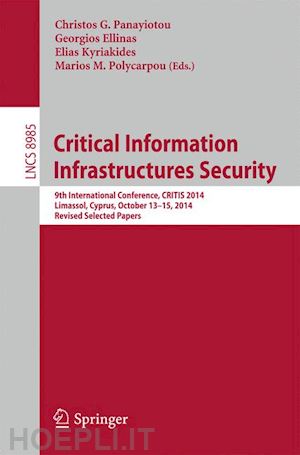
Questo prodotto usufruisce delle SPEDIZIONI GRATIS
selezionando l'opzione Corriere Veloce in fase di ordine.
Pagabile anche con Carta della cultura giovani e del merito, 18App Bonus Cultura e Carta del Docente
This book constitutes revised selected papers from the 9th International Conference on Critical Information Infrastructures Security, CRITIS 2014, held in Limassol, Cyprus, in October 2014.
The 20 full and 19 short papers presented in this volume were carefully reviewed and selected from 74 submissions. They are organized in topical sections named: cyber-physical systems and sensor networks; security of water systems; power and energy system security; security and recovery policies, cyber security; and security tools and protocols.
Cyber-Physical Systems and Sensor Networks.- Fault Detection and Isolation in Critical Infrastructure Systems.- Critical Infrastructure in the Future City - Developing Secure and Resilient Cyber–Physical Systems.- Exploitation of HART Wired Signal Distinct Native Attribute (WS-DNA) Features to verify Field Device Identity and Infer Operating State.- Processing and Communications Rate Requirements in Sensor Networks for Physical Thread Assessment.- A Comprehensive Approach for Security Assessment in Transport.- Security of Water Systems.- Decentralised Hierarchical Multi-rate Control of Large-scale Drinking Water Networks.- dbpRisk: Disinfection By-Product Risk Estimation.- Gaussian-Process-based Demand Forecasting for Predictive Control of Drinking Water Networks.- Graph-Based Hydraulic Vulnerability Assessment of Water Distribution Networks.- Sensor Data Validation and Reconstruction in Water Networks: A Methodology and Software Implementation.- Critical Infrastructure Online Fault Detection: Application in Water Supply Systems.- Power and Energy System Security.- An Attack Analysis of Managed Pressure Drilling Systems on Oil Drilling Platforms.- The Effect of Branch Parameter Errors to Voltage Stability Indices.- CFD Simulation of Contaminant Transportation in High-Risk Buildings using CONTAM.- Detection and Management of Large Scale Disturbances in Power System.- Impact of Surface Nuclear Blast on the Transient Stability of the Power System.- Building an Integrated Metric for Quantifying the Resilience of Interdependent Infrastructure Systems.- Calculation of Cyber Security Index in the Problem of Power System State Estimation based on SCADA and WAMS Measurements.- Factors influencing Oscillations within Meshed HVDC Grids and Implications for DC Voltage Control.- Security and Recovery Policies.- Public-private Partnership: The Missing Factor in the Resilience Equation - The French Experience on CIIP.- Enterprise Security Analysis and Training Experience.- Using Programmable Data Networks to Detect Critical Infrastructure Challenges.- Security Stress: Evaluating ICT Robustness through a Monte Carlo Method.- Cyber Security.- Model-based Evaluation of the Resilience of Critical Infrastructures under Cyber Attacks.- The Role of One-Class Classification in Detecting Cyberattacks in Critical Infrastructures.- Cyber Attacks in Power Grid ICT Systems leading to Financial Disturbance.- Obfuscation of Critical Infrastructure Network Traffic using Fake Communication.- CyNetPhy: Towards Pervasive Defense-in-Depth for Smart Grid Security.- Faults and Cyber Attacks Detection in Critical Infrastructures.- Security Tools and Protocols.- Recovering Structural Controllability on Erdos–Rényi Graphs via Partial Control Structure Re-Use.- Self-healing Protocols for Infrastructural Networks.- PRoCeeD: Process State Prediction for CRITIS using Process Inherent Causal Data and Discrete Event Models.- Cascading Failures: Dynamic Model for CIP Purposes - Case of Random Independent Failures following Poisson Stochastic Process.- A Security Assessment Methodology for Critical Infrastructures.- Automatic Fault Identification in Sensor Networks Based on Probabilistic Modeling.- Improving Situational Awareness for First Responders.- A Decision Support System for Emergency Management of Critical Infrastructures subjected to Natural Hazards.- Progressive Recovery from Failure in Multi-layered Interdependent Network Using a New Model of Interdependency.- Model-based Security Risk Analysis for Networked Embedded Systems.











Il sito utilizza cookie ed altri strumenti di tracciamento che raccolgono informazioni dal dispositivo dell’utente. Oltre ai cookie tecnici ed analitici aggregati, strettamente necessari per il funzionamento di questo sito web, previo consenso dell’utente possono essere installati cookie di profilazione e marketing e cookie dei social media. Cliccando su “Accetto tutti i cookie” saranno attivate tutte le categorie di cookie. Per accettare solo deterninate categorie di cookie, cliccare invece su “Impostazioni cookie”. Chiudendo il banner o continuando a navigare saranno installati solo cookie tecnici. Per maggiori dettagli, consultare la Cookie Policy.